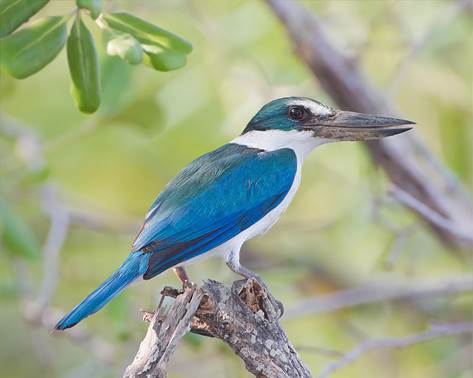This is a relatively common species that inhabits the Northern Mariana Islands. It once was thought to be a subspecies of the collared kingfish that exhibits a wider western Pacific distribution but was give the species level after more analysis. The have a distinct large, blocky bill with bright blue/greenish coloration on their head and back and bright blue wings and a white collar and underbelly. There are several subspecies in the Mariana Islands, some endemic to just one island. These birds are about 8.5 – 11.5 inches long and weigh 1.8 – 3.2 ounces. Females tend to be greener than the males and the immature birds have duller color.
They prefer forest and savannah habitat but can be found in a wide variety of habitats. They eat a range of items including insects, worms, snails, shrimp, frogs, lizards, and small fish. They occasionally prey on small birds. It typically perches and then glides down upon its prey. Indigestible items are regurgitated as pellets.
The kingfishers nest in burrows in earth or in tree cavities. They lay 2 – 7 eggs on the floor of the burrow without bringing in nest material. Both parents care for the young who leave the nest in about 45 days. Being in the tropics they usually produce two broods a year.
The genus name, Todiramphus, is a combination of ‘todus’, the Latin word for tody, a family of small birds related to kingfishers, and ‘ramphos’, the Greek word for bill. The species name albicilla for the white underside. The scientific name can thus be translated as ‘whitish tody-bill’.
A Chamorro story about a similar species, the Guam kingfisher goes like this:
A village woman was always talking loudly and making trouble. She wore an orange kerchief and a blue dress with a white apron. An angry “taotaomo’na” (spirit of Chamorro ancestors) then turned the woman into the first sihek (Guam kingfisher). Her clothing became the colors of the female sihek and now the unhappy bird calls loudly when people are near.
Here’s a collard kingfisher call, which is similar: http://ibc.lynxeds.com/sound/collared-kingfisher-todiramphus-chloris/subject-was-tending-nest-so-somewhat-unhappy-i-was-the
While the population of these birds is doing well, the largest concern is the introduction of the brown tree snake, a voracious non-native predator that was introduced to Guam and has decimated its native bird population.
I saw these birds on the island of Tinian last year while on the old runway where the Enola Gay took off from in WW II. Several, maybe a family group, were hanging around the trees and periodically flying down to the ground to capture an insect or lizard. It was a little odd to see such a large kingfisher away from the water – our North American native, the belted kingfisher, is rarely far from open water and feeds primarily on fish. And the bright colors on this bird are quite tropical looking.
